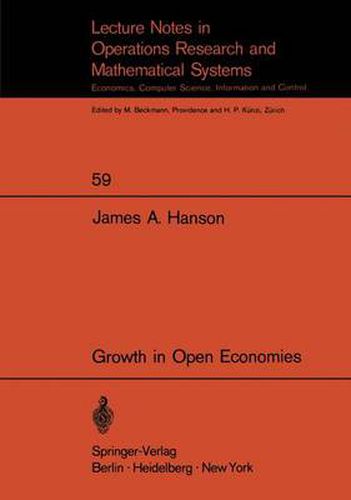Readings Newsletter
Become a Readings Member to make your shopping experience even easier.
Sign in or sign up for free!
You’re not far away from qualifying for FREE standard shipping within Australia
You’ve qualified for FREE standard shipping within Australia
The cart is loading…






This title is printed to order. This book may have been self-published. If so, we cannot guarantee the quality of the content. In the main most books will have gone through the editing process however some may not. We therefore suggest that you be aware of this before ordering this book. If in doubt check either the author or publisher’s details as we are unable to accept any returns unless they are faulty. Please contact us if you have any questions.
The years following World War II have witnessed an increasing interest in the effects of growth on trade, the patterns of international specialization, and the terms of trade. On the one hand, some English economists have maintained the Ricardian tradition of diminishing returns, rising food prices and, therefore, declining British terms of trade, while,on the other hand Prebisch, Singer, and other critics have attempted to document and explain a long-run decline in the terms of trade of the underdeveloped countries. Finally, in a reaction to this concentration on a single factor as the determinant of international price movements, a group of economists, began a systematic investigation of the role of growth in trade and the terms of trade using neoclassical assumption. This study,particularly in its assumptions regarding demand, falls into the tradition of the last group. However, it extends the tradition by treating growth as a continuous process, dependent on saving out of produced income and the growth rate of population in two trading economies. Therefore, in addition to answering the comparative statics questions regarding the trends in the terms of trade, it develops the conditions which guarantee that the two economies will approach a state of unique long-run balanced growth, in which all per capita variables, as well as the terms of trade, stabilize. Moreover, these methods permit some discussion of changes in the patterns of specialization.
$9.00 standard shipping within Australia
FREE standard shipping within Australia for orders over $100.00
Express & International shipping calculated at checkout
This title is printed to order. This book may have been self-published. If so, we cannot guarantee the quality of the content. In the main most books will have gone through the editing process however some may not. We therefore suggest that you be aware of this before ordering this book. If in doubt check either the author or publisher’s details as we are unable to accept any returns unless they are faulty. Please contact us if you have any questions.
The years following World War II have witnessed an increasing interest in the effects of growth on trade, the patterns of international specialization, and the terms of trade. On the one hand, some English economists have maintained the Ricardian tradition of diminishing returns, rising food prices and, therefore, declining British terms of trade, while,on the other hand Prebisch, Singer, and other critics have attempted to document and explain a long-run decline in the terms of trade of the underdeveloped countries. Finally, in a reaction to this concentration on a single factor as the determinant of international price movements, a group of economists, began a systematic investigation of the role of growth in trade and the terms of trade using neoclassical assumption. This study,particularly in its assumptions regarding demand, falls into the tradition of the last group. However, it extends the tradition by treating growth as a continuous process, dependent on saving out of produced income and the growth rate of population in two trading economies. Therefore, in addition to answering the comparative statics questions regarding the trends in the terms of trade, it develops the conditions which guarantee that the two economies will approach a state of unique long-run balanced growth, in which all per capita variables, as well as the terms of trade, stabilize. Moreover, these methods permit some discussion of changes in the patterns of specialization.